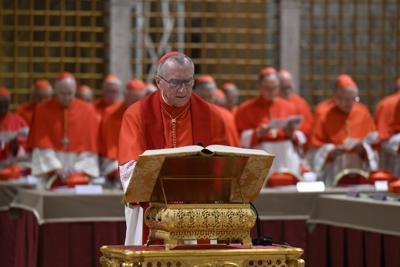The steps leading to the selection of Pope Leo XIV this week attracted fascination worldwide.
The billowing white smoke signaling the naming, the sequestering of the cardinals while they deliberated, the secrecy, the power of the papacy, the drama of the wait ā all of this and more made for a compelling, tension-filled news story.
At the Star we also learned a tough, but very important lesson this week about covering this story: that news surrounding the process isnāt always reliable ā even when it comes from seemingly reliable sources.
In our print and online editions last Sunday, we published a 1,521-word article about how the pope is chosen and who the front runners were.
A section of the piece referenced Cardinal Pietro Parolin, a former Vatican secretary of state and long-time diplomat, widely considered one of the top contenders. We reported that there was a reminder of the stakes involved in picking a new pope, when Parolinās blood pressure āreportedly spiked this weekā sending Vatican doctors scrambling to Parolinās aid.
Monday morning, I popped open an email from reader Alan, a pc28¹ŁĶųresident, who told us to ācheck your factsā regarding the point about Parolinās health and subsequent medical attention.
āMatteo Bruni, director of the Holy See press office, reported that this did not happen,ā Alan stated ā the Holy See being the governing body for the Catholic Church that includes the pope and advisers.
I reached out to veteran Star journalist Allan Woods, the author of the article. I also got in touch with the editors who handled the story.
As it turns out, we didnāt pick up the statement last Friday from the Vatican that shot down the report on Parolin in time to revise the article. We werenāt alone, however, in printing the erroneous detail.
We ran a correction early this week quoting the Vatican spokesperson. Other media outlets in other countries published corrections too.
As public editor, getting into the details of what went wrong here was very instructive for me.
Woods, a Paris-based veteran staff reporter, who covers global and national affairs, told me he first saw a post about Parolinās alleged health episode on the platform X. It came May 1 from a rather good source ā Diane Montagna, the Rome correspondent for the Catholic Herald, a well-known and respected Roman Catholic magazine.
According to multiple sources ā¦ an āalertā was triggered in the Vatican concerning the health of Parolin, one of the leading papal contenders, Montagna said in her post.
She cited an elevated blood pressure issue and that a medical team assisted Parolin for an hour. She attributed the report to an Italian journalist from the daily Rome publication Il Tempo.
After the Vatican clarified things, questions began being asked about who initially launched the false report.
The ran an , reporting that there was finger pointing regarding who was responsible.
“At the moment, the American Catholic site and several Italian news agencies seem to be in a contest to see who can off-load responsibility for the rumour on the other,” the Catholic Herald’s website stated.
The publication later added a note of intrigue ā that the āhunt seemed to be on to identify who was responsible for a report now seen as a fairly naked attempt to sabotage Parolinās chances.ā
I reached out to a local expert on the Catholic Church, Mark McGowan, a professor of history at the University of Torontoās St. Michaelās College, who told me there may indeed have been some orchestrated mischief behind the erroneous account of Parolinās health.
ā(Parolin) has a progressive side to him, so those who would like to undermine that candidacy could easily start spreading rumours,ā McGowan told me in a telephone interview.
McGowan added that the Italian media had been blamed by some, but “things in a way smell bad” when is mentioned.
“Youāve probably heard of them. They are kind of a cultural warrior, conservative Catholic, online site, that certainly wouldnāt like a progressive pope,ā McGowan said.
As public editor I did reach out to in the U.S. to get their side of what happened. In an email to me Thursday, the organization said they didn’t invent the story, they only reported what the Italian press reported, then retracted the report when the Vatican denied it.
Yet some Italian media outlets have cited as the originator.
So, weāre left with a bit of a whodunit.
The lessons? McGowan said anytime an extraordinary piece of information comes out of Rome pertaining to the Vatican āyou really have to weigh it with great care.ā
Woods, the author of the Star article, had a similar take in the aftermath.
He said the world’s media turn necessarily to the Vatican correspondents and the specialized Catholic publications at times such as this and this can lead to an āabsence of independent expertise.ā
This gap in information and access and resulting āvulnerabilityā is compounded by the fact that the church conducts so much of its business (like the pre-conclave meetings) behind closed doors, Woods told me.
This isnāt an excuse for retransmitting information that the Vatican said was incorrect ā but is important context, nevertheless, Woods added.
From my vantage point as public editor, I would call this a cautionary episode for any journalists covering the Vatican.



























To join the conversation set a first and last name in your user profile.
Sign in or register for free to join the Conversation